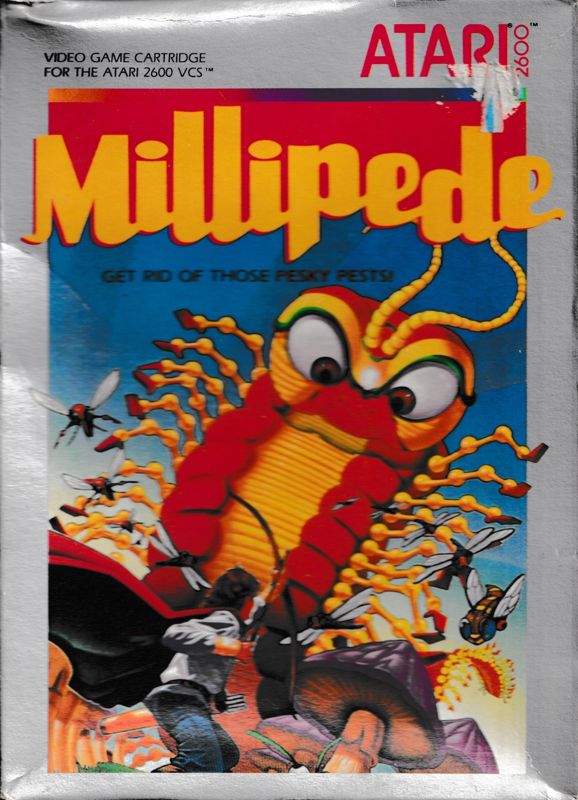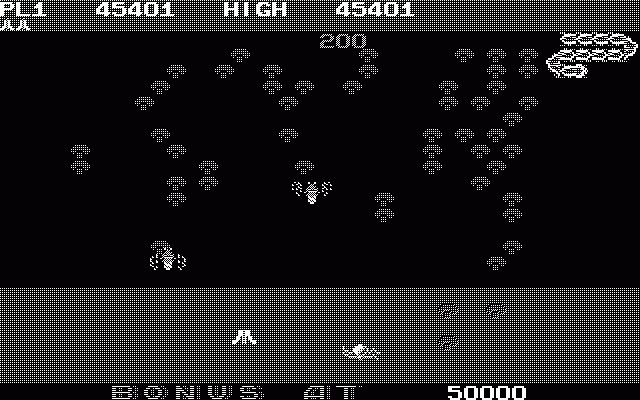Retro Replay Review
Gameplay
Millipede carries forward the fast-paced, single-screen shooter action that made its predecessor, Centipede, a household name. Players control a stationary bug zapper at the bottom of the screen, firing upwards to intercept a multi-segmented millipede as it weaves through a maze of mushrooms. The core loop is simple to grasp yet increasingly challenging: each segment you destroy shortens the millipede but also increases its speed, demanding ever-sharper reflexes and strategic positioning.
(HEY YOU!! We hope you enjoy! We try not to run ads. So basically, this is a very expensive hobby running this site. Please consider joining us for updates, forums, and more. Network w/ us to make some cash or friends while retro gaming, and you can win some free retro games for posting. Okay, carry on 👍)
Beyond the signature millipede, a host of new insect adversaries—spiders, bees, dragonflies, and earwigs—adds variety and unpredictability. Each creature moves in its own distinct pattern, forcing you to juggle multiple threats at once. For instance, spiders skitter across the floor in erratic bursts, while bees dart unpredictably in small swarms. Learning these movement patterns is key to clearing each wave without being overwhelmed.
A standout twist is the arrival of DDT canisters, which function almost like area-of-effect bombs when shot. A well-timed hit can obliterate nearby insects and mushroom clusters, creating breathing room in the densest moments. This mechanic introduces a satisfying layer of risk and reward: aiming at a floating canister might clear half the screen, but a missed shot could let the millipede close in on you even faster.
The level progression is merciless in its difficulty curve. Early screens lull you into a false sense of security, but as you clear more segments, the swarm intensifies. Mushroom forests become denser, insect waves increase in quantity and aggression, and DDT canisters appear less predictably. Long-time arcade fans will appreciate the emphasis on high-score mastery, as every insect type awards different points, encouraging you to prioritize targets for maximum reward.
Graphics
True to its arcade roots, Millipede employs bright, 8-bit–style sprites that pop against a contrasting background. The mushrooms are rendered in clear, blocky hues of red and white, making it easy to track the millipede’s winding path. Each insect species boasts its own distinctive palette and animation cycle, ensuring you never confuse a harmless earwig for a high-value dragonfly.
Animations are smooth for a classic arcade title. The millipede’s segmented movement feels fluid as it descends turn by turn, and the buzzing flight of bees is convincingly jittery. Even the DDT canister flickers with a subtle, blinking effect that draws your eye, a clever design choice that turns it into both a risk and an opportunity.
While there’s no sweeping background art or parallax scrolling, the single-screen design remains visually engaging thanks to smart use of color and pixel-perfect hit detection. Every bullet, explosion, and mushroom collision is clear and immediate, which is crucial when milliseconds count. The minimalist presentation keeps you focused squarely on the action.
Story
In purely arcade terms, Millipede’s narrative is delightfully straightforward: a tranquil garden has been overrun by ravenous millipedes and their insect allies, and only your trusty bug zapper stands in their way. There’s no cinematic intro or voiced cutscene—just an implicit understanding that nature can be brutal if left unchecked.
This bare-bones premise works in Millipede’s favor, as it places all emphasis on gameplay. You don’t need pages of backstory to care about saving the garden; the visceral thrill of worming your way through wave after wave of insects is motivation enough. The garden setting, implied by the sea of mushrooms and darting dragonflies, provides a charming backdrop that never distracts from the core action.
Interestingly, the game’s title sequence and attract mode hint at a larger ecosystem beyond each screen. When you’re not playing, a looping scene shows the mushroom forest teeming with life—until the zapper’s beam cuts through the chaos. It’s a subtle reminder that you’re part of a tiny, valiant stand against an overwhelming natural onslaught.
For players seeking a rich narrative experience, Millipede won’t compete with story-driven epics. However, its minimalist storytelling is perfectly in tune with the arcade philosophy of “easy to learn, hard to master,” letting you project your own heroism onto a simple, yet compelling, garden defense mission.
Overall Experience
Playing Millipede is like rediscovering an old arcade gem with just enough new features to feel fresh. The combination of fast-moving millipedes, colorful insect swarms, and destructive DDT canisters makes each session a high-stakes puzzle of motion and timing. Whether you’re gunning for a new personal best or simply enjoying a few frantic minutes of shooting action, the gameplay remains finely tuned and endlessly replayable.
Casual players will find the early levels inviting, though the steep difficulty ramp means don’t be surprised if your high-score ambitions end abruptly. For competitive arcade enthusiasts, this is a feature, not a flaw: the constant challenge keeps you hooked, and conquering that next level provides a genuine rush.
While modern gaming offers sprawling worlds and narrative depth, there’s a timeless appeal in Millipede’s distilled design. It’s easy to pick up, everyone understands the premise in seconds, and the screen never gets dull. In short bursts or extended marathons, Millipede delivers a satisfyingly direct arcade experience that still holds up decades after its release.
Overall, Millipede is a must-try for fans of retro shooters and score-chasing, twitch-reflex gameplay. It may lack bells and whistles, but its core mechanics—fast action, clear visuals, tight controls, and escalating difficulty—make it a perennial favorite for anyone who appreciates pure, unadulterated arcade fun.
 Retro Replay Retro Replay gaming reviews, news, emulation, geek stuff and more!
Retro Replay Retro Replay gaming reviews, news, emulation, geek stuff and more!









Reviews
There are no reviews yet.